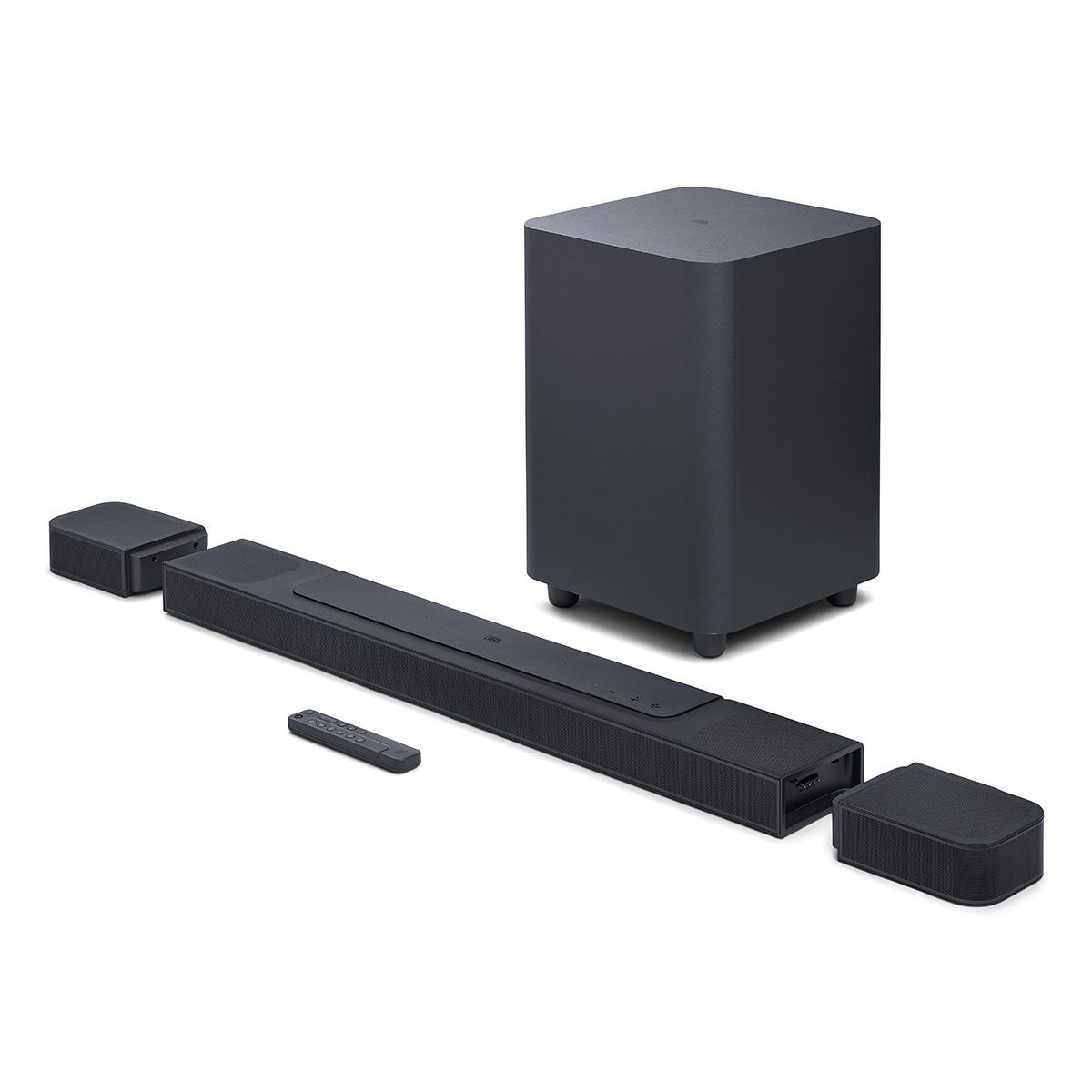
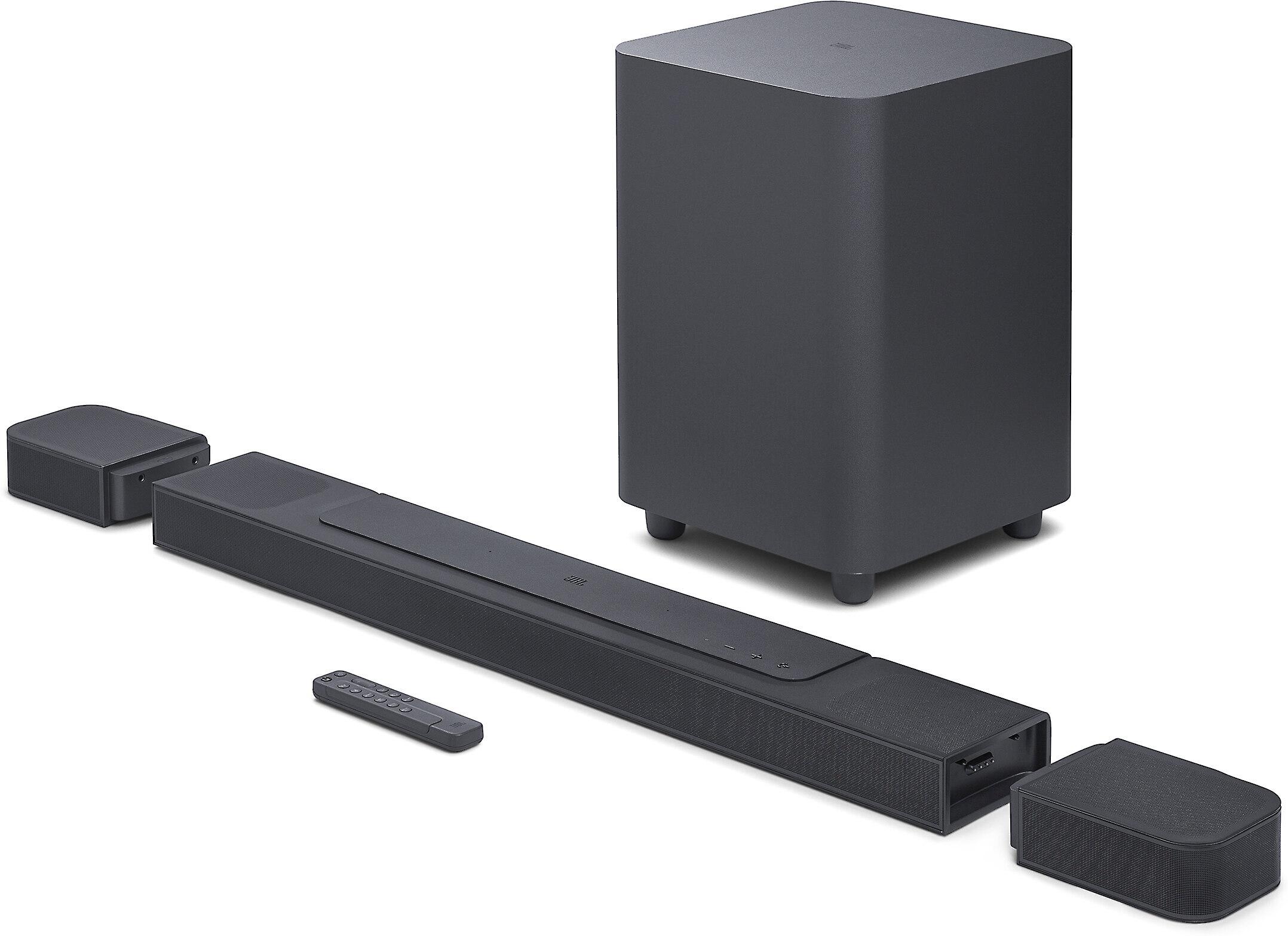
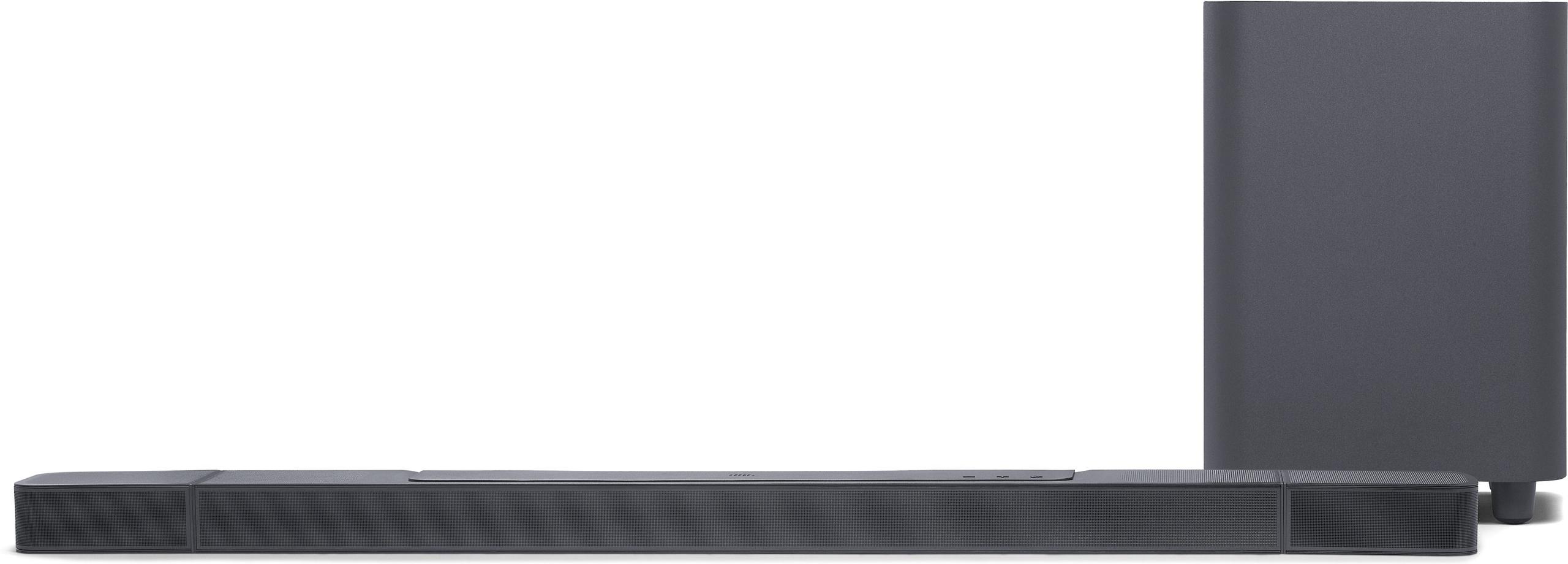
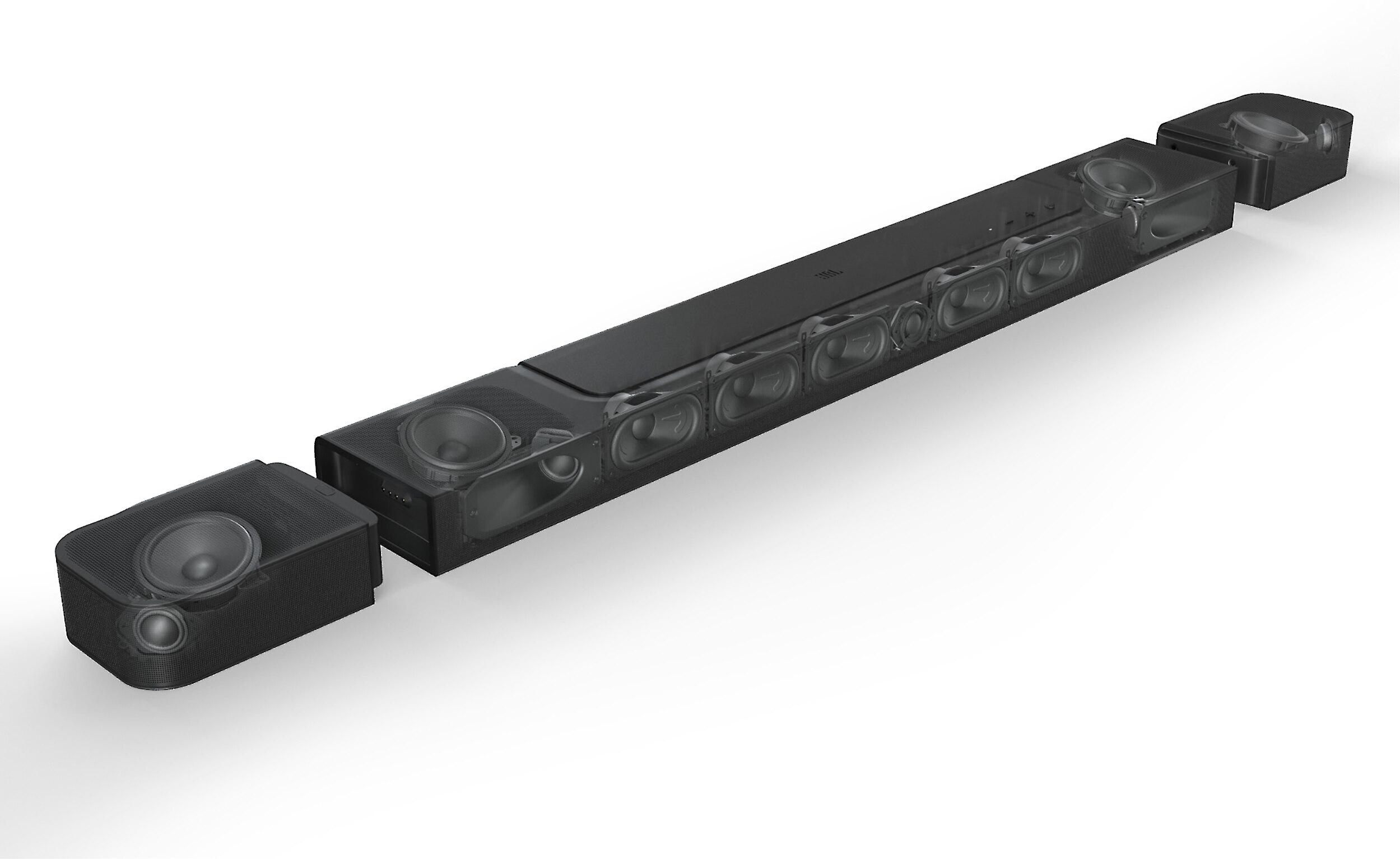
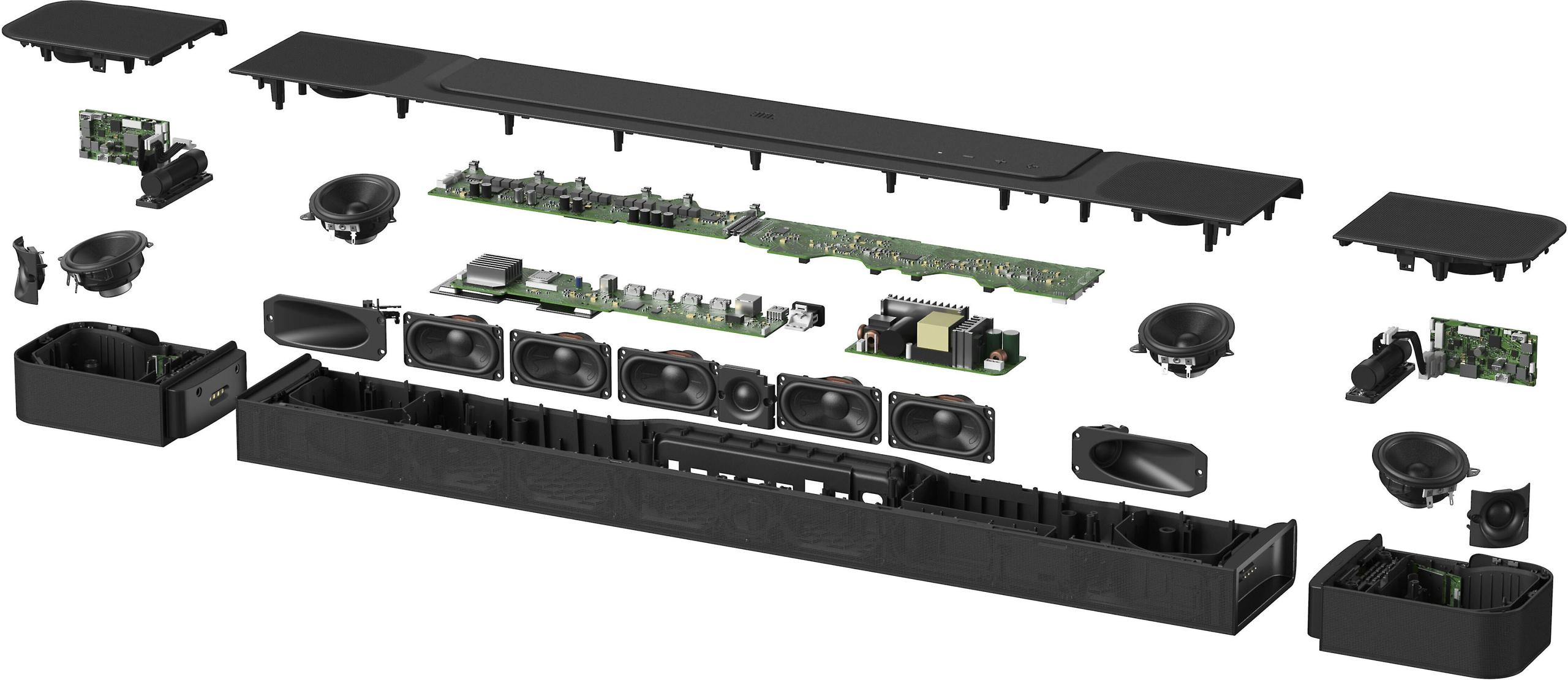

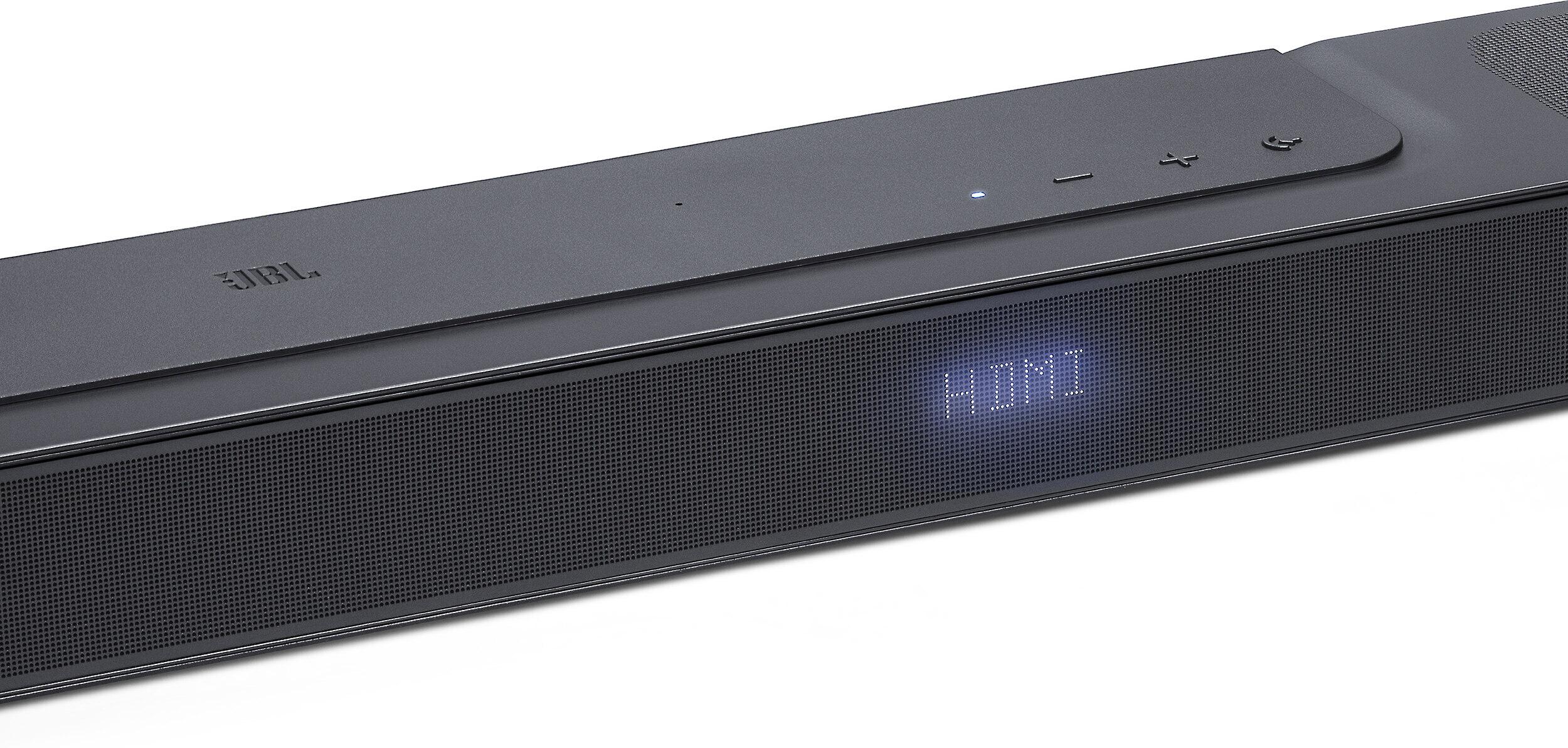




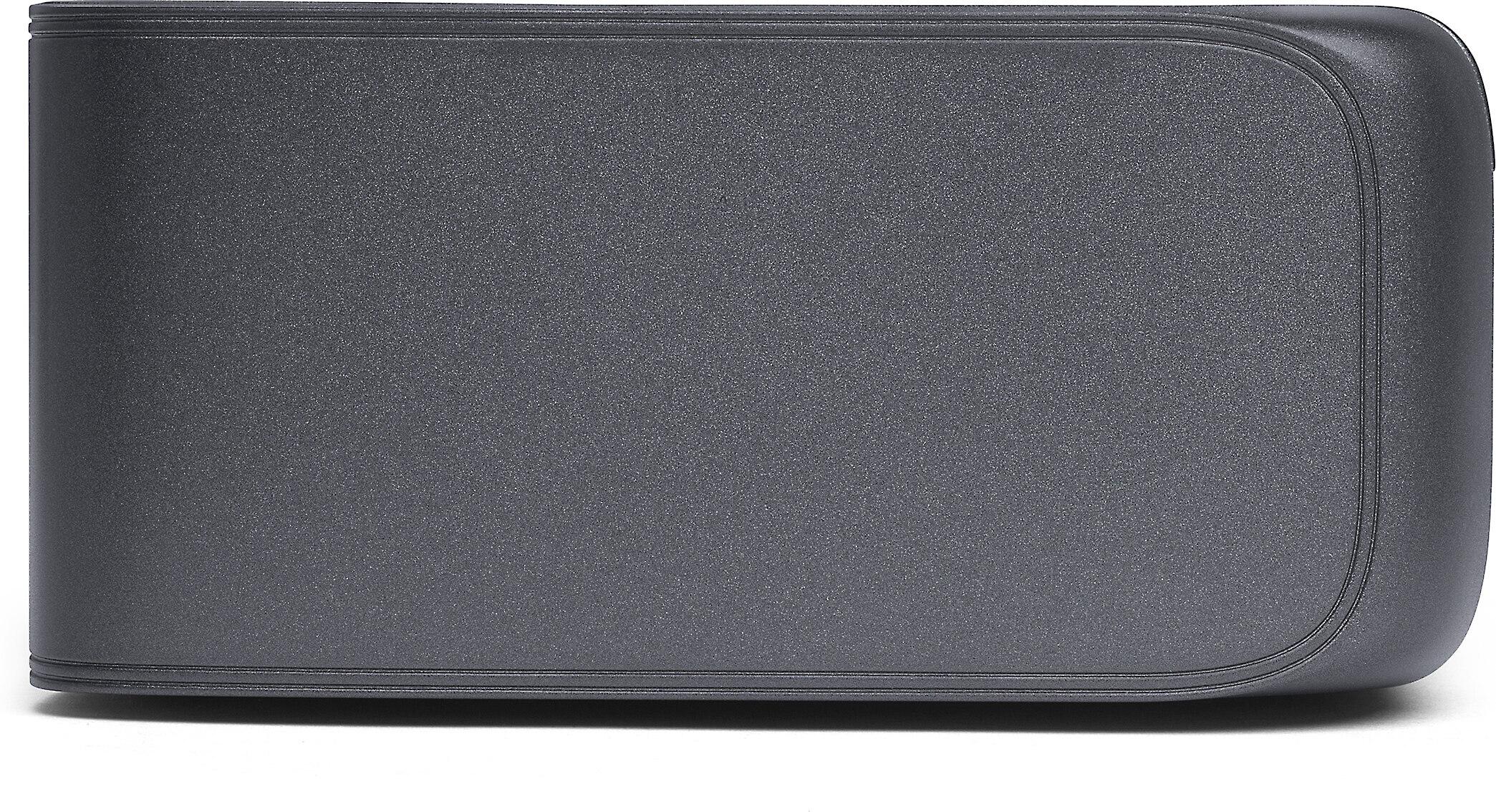












$699.95
When JBL Bar 1000 launched in late 2022, it marked a significant evolution in how we think about premium home theater audio. After extensive testing in our home theater lab and real-world environments, we've found this system strikes an impressive balance between convenience and performance that's worth exploring in detail.
The home theater landscape has changed dramatically since the pandemic, with more people investing in quality audio setups for their homes. The JBL Bar 1000 entered the market when consumers were increasingly demanding Dolby Atmos capability (which creates a three-dimensional sound field) and simplified setup processes.
In our testing environment, we've noticed that modern premium soundbars like this one are closing the gap with traditional component systems, especially in rooms under 500 square feet. The integration of streaming services and smart home features has become essential, not just optional.
Setting up the Bar 1000 is remarkably straightforward, especially considering its capabilities. The main soundbar unit measures 47.6 inches wide, making it ideal for TVs 55 inches and larger. During our installation process, we particularly appreciated the well-thought-out packaging that clearly labels each component.
The wireless rear speakers represent one of the system's most innovative features. Unlike traditional surround speakers that require permanent installation and wiring, these detach from the main soundbar and can be placed anywhere in your room. They run on rechargeable batteries that last about 10 hours - perfect for movie marathons or weekend binge-watching sessions.
The system's 7.1.4 channel configuration (7 surround channels, 1 subwoofer, 4 height channels) delivers impressive spatial audio. During our testing with films like "Dune" and "Top Gun: Maverick," the overhead effects were notably precise - you can actually hear aircraft moving across the ceiling. This is achieved through four up-firing speakers that bounce sound off your ceiling to create height effects.
The included 10-inch wireless subwoofer provides substantial low-end impact. In our testing room (approximately 400 square feet), the bass remained tight and controlled even at high volumes. While testing with music, particularly tracks like "Bad Guy" by Billie Eilish, the subwoofer demonstrated excellent articulation without overwhelming the mix.
JBL's PureVoice technology deserves special mention. This feature uses algorithms to enhance dialogue frequencies, making conversations clear even during intense action scenes. We found this particularly effective when watching Christopher Nolan films, which are notorious for complex sound mixing.
The JBL Bar 1000 excels in the connectivity department. The inclusion of HDMI eARC (Enhanced Audio Return Channel) allows for uncompressed audio transmission from your TV through a single cable. During our testing, this proved especially valuable for maintaining audio sync with fast-paced gaming content.
Built-in Wi-Fi enables streaming from:
The JBL One app provides comprehensive control over the system, including:
In our dedicated testing environment, we ran through a variety of content types. The system particularly shined with modern action films. During a screening of "Mad Max: Fury Road," the combination of precise overhead effects and powerful bass created an incredibly immersive experience.
While primarily designed for home theater use, the Bar 1000 handles music remarkably well. The system's MultiBeam technology creates a wide soundstage that works especially well for orchestral music and live recordings. We found jazz and classical pieces particularly well-served by the precise imaging.
Modern gaming demands low latency and precise audio positioning. The Bar 1000's HDMI 2.1 compatibility ensures it keeps up with the latest gaming consoles. During testing with PS5 titles like "Horizon Forbidden West," the spatial audio positioning provided a genuine competitive advantage.
At its price point ($1,000-$1,200), the Bar 1000 competes with systems like the Sonos Arc and Samsung Q990B. While slightly more expensive than some alternatives, it justifies the premium through:
After several months of testing, a few points stand out regarding long-term ownership:
The JBL Bar 1000 represents a significant achievement in home theater audio. It successfully bridges the gap between traditional component systems and simple soundbars, offering premium performance without the complexity of separate receivers and speakers.
While the price point places it in the premium category, the performance and feature set justify the investment for those seeking high-quality audio without complex installation requirements. The system particularly excels in providing genuine Dolby Atmos effects and maintains exceptional clarity across all content types.
For users wanting a significant upgrade from basic soundbars without the complexity of component systems, the Bar 1000 represents an excellent balance of performance, features, and usability. It's particularly well-suited for modern homes where simplicity and performance need to coexist.
The continuing firmware updates and robust build quality suggest this system will remain relevant and capable for years to come, making it a solid long-term investment in your home entertainment setup.
The JBL Bar 1000 is worth the investment for home theater enthusiasts seeking premium audio quality without complex installation. At its price point, it offers true Dolby Atmos performance, innovative detachable surrounds, and excellent build quality that justifies the cost for those wanting high-end home theater audio.
Due to its 47.6-inch width, the JBL Bar 1000 is best paired with TVs 55 inches or larger. This ensures proper aesthetic balance and optimal sound dispersion across your viewing area.
Yes, the system fully supports Dolby Atmos from all major streaming services including Netflix, Disney+, and Amazon Prime Video when connected via HDMI eARC to a compatible TV.
The detachable surround speakers last approximately 10 hours on a single charge. They automatically recharge when reattached to the main soundbar unit.
Yes, the JBL Bar 1000 comes with wall-mounting brackets for both the main soundbar and the detachable surround speakers, allowing flexible installation options.
The system works excellently with gaming consoles through its HDMI inputs, supporting 4K/60Hz passthrough and providing low-latency audio performance ideal for gaming.
The system performs optimally in rooms up to 500 square feet. The automatic room calibration feature adjusts the sound profile to match your specific room dimensions and acoustics.
Yes, the JBL Bar 1000 supports multiple streaming options including Wi-Fi, Bluetooth, AirPlay 2, and Chromecast built-in, with access to over 300 streaming services.
While the surround speakers are battery-powered, the 10-inch subwoofer requires constant power through an electrical outlet. However, it connects wirelessly to the main soundbar for audio.
The JBL Bar 1000 offers comparable performance to many traditional home theater systems while being significantly easier to set up and manage. It provides true 7.1.4 channel audio with the convenience of a predominantly wireless system, making it an excellent choice for those who want premium sound without the complexity of separate components.
We've done our best to create useful and informative comparisons to help you decide what product to buy. Our research has used advanced automated methods to create this comparison and perfection is not possible - please contact us for corrections or questions. These are the sites we've researched in the creation of this article: zdnet.com - jbl.com - jbl.com - pcrichard.com - rtings.com - d21buns5ku92am.cloudfront.net - ro.harmanaudio.com - target.com - harmanaudio.com - dell.com - mm.jbl.com - dolby.com - jbl.com.my - videoandaudiocenter.com
| JBL Bar 1000 |
|---|
| Total System Power - Determines overall volume capability and dynamic range: 880W |
| Channel Configuration - Defines surround sound capability: 7.1.4 |
| Up-firing Speakers - Creates overhead sound effects: 4 total (2 in soundbar, 2 in surrounds) |
| Subwoofer Size - Larger size generally means better bass extension: 10-inch wireless |
| Surround Speaker Battery Life: 10 hours |
| Frequency Response - Range of sounds system can reproduce: 33Hz - 20kHz (-6dB) |
| HDMI Inputs - For connecting multiple devices: 3 inputs + 1 eARC |
| Wireless Connectivity: Wi-Fi, Bluetooth, AirPlay, Chromecast built-in |
| Soundbar Width - Important for TV size matching: 47.6 inches |
| Audio Format Support: Dolby Atmos, DTS:X, MultiBeam Surround |
| Room Calibration - Optimizes sound for your space: Automatic via built-in mic |
| Power Consumption in Standby: < 2.0W |
| Maximum Operating Temperature: 45°C |
| App Control: JBL One app |
The Yamaha SR-B40A ($399.95) offers impressive performance for its price point, particularly in smaller to medium-sized rooms. Its virtual surround processing and Clear Voice technology deliver crisp dialogue and a surprisingly wide soundstage, while the 6.5-inch wireless subwoofer provides adequate bass for most content. The simplified 2.1 channel configuration means easier setup and fewer components to manage, making it an attractive option for those wanting better TV sound without the complexity of a full surround system.
While it can't match the JBL Bar 1000's true surround sound capabilities or Dolby Atmos performance, the Yamaha SR-B40A represents excellent value for everyday TV watching and casual music listening. Its compact design and straightforward operation make it particularly well-suited for apartments or situations where space is limited. The sound quality punches above its price class, and while it won't deliver the same immersive experience as physical rear speakers, its virtual processing creates an engaging audio experience that significantly improves upon built-in TV speakers.
🤖 Read Detailed Comparison
👌Yamaha SR-B40A 2.1-Channel Sound Bar with Wireless Subwoofer Details
💵 See Yamaha SR-B40A 2.1-Channel Sound Bar with Wireless Subwoofer Price
The $899 Bose Smart Ultra takes a more streamlined approach to premium home theater sound, packing impressive virtual surround capabilities into a single, elegant unit. While it can't match the JBL's physical speaker separation, its advanced processing and AI-powered features create a convincingly immersive soundstage that works particularly well in small to medium-sized rooms. The standout AI Dialogue Mode, which leverages machine learning trained on millions of audio samples, provides exceptional voice clarity without manual adjustments. This single-unit design also means significantly simpler setup and less complexity in day-to-day use, making it an attractive option for those who want superior sound without managing multiple components.
Where the Bose really shines is in its versatility and expandability. The sleek, compact design (just 2.25 inches high) fits seamlessly into most TV setups, and its room calibration system optimizes performance for any space. While the integrated subwoofer can't match the depth of JBL's dedicated 10-inch unit, it provides balanced bass that's more than adequate for most content. The $190 lower price point makes it a more accessible entry into premium sound, and users have the flexibility to add a separate subwoofer or surround speakers later if desired. The smart features are also more refined, with better voice assistant integration and multi-room audio capabilities, making it an excellent choice for those who prioritize smart home integration and clean aesthetics over maximum surround sound immersion.
🤖 Read Detailed Comparison
👌Bose Smart Ultra Soundbar with Dolby Atmos Details
💵 See Bose Smart Ultra Soundbar with Dolby Atmos Price
The JBL Bar 700 offers an impressive value proposition, delivering many of the Bar 1000's key features at a more accessible $899.95 price point. While it uses virtual height effects instead of physical up-firing drivers, its MultiBeam technology creates convincing overhead sound that works particularly well in small to medium-sized rooms with standard ceiling heights. The 5.1 channel configuration, powered by 620W of total system power, provides enough punch for most home theater applications, and the included 10" wireless subwoofer delivers similar bass performance to its more expensive sibling. The Bar 700's PureVoice technology ensures clear dialogue, while the detachable wireless surround speakers offer flexible placement options for various room layouts.
For many users, especially those with typical living room setups or smaller spaces, the Bar 700's performance advantages over basic soundbars will be more noticeable than its limitations compared to the Bar 1000. The $240 saved could be better spent on other home theater components, particularly if you're not in a position to fully utilize true height channels or additional power. While it doesn't match the Bar 1000's precise spatial audio or advanced room calibration, the Bar 700's virtual processing and automatic calibration deliver impressive results that will satisfy most listeners, making it an excellent choice for those seeking premium sound without the premium price tag.
🤖 Read Detailed Comparison
👌JBL Bar 700 Dolby Atmos 5.1 Soundbar with Subwoofer Details
💵 See JBL Bar 700 Dolby Atmos 5.1 Soundbar with Subwoofer Price
The JBL Bar 300 offers a more streamlined and budget-friendly approach, delivering surprisingly capable audio from a single compact soundbar. Priced at $349.95, it focuses on the essentials with a 5.0 channel configuration and built-in bass port that works particularly well for dialogue clarity and regular TV viewing. While it can't match the Bar 1000's immersive surround experience, its PureVoice technology ensures clear speech even during busy scenes, and its virtual surround processing creates a respectably wide soundstage that extends beyond the physical soundbar.
For smaller rooms and apartments where space is at a premium, the Bar 300's all-in-one design eliminates the need for multiple speakers and cable management. Its simplified setup process and more modest bass output make it an ideal choice for those who want better TV audio without disturbing neighbors or overwhelming their space. While it lacks the height channels and true surround capabilities of the Bar 1000, its streaming features and HDMI eARC support provide modern connectivity at a more accessible price point. The Bar 300 represents an excellent value for users seeking a significant upgrade from TV speakers without the complexity and cost of a full home theater system.
🤖 Read Detailed Comparison
👌JBL Bar 300 5.0 Soundbar Details
💵 See JBL Bar 300 5.0 Soundbar Price
The Sennheiser AMBEO Mini ($399.99) takes a dramatically different approach to home theater sound, focusing on sophisticated virtual surround processing from a single compact unit. While it can't match the JBL's true surround capabilities, it delivers impressive performance through advanced beamforming technology and carefully tuned drivers. The AMBEO's virtualization creates a surprisingly wide soundstage and convincing height effects, making it an excellent choice for smaller rooms or situations where multiple speakers aren't practical. The built-in woofers provide adequate bass for most content, though they naturally can't compete with a dedicated subwoofer.
At roughly one-third the price of the JBL system, the AMBEO Mini represents compelling value for those prioritizing simplicity and space efficiency over maximum performance. Its single-unit design eliminates the need for speaker placement and cable management, while still delivering engaging audio for movies, TV shows, and music. While home theater enthusiasts might miss the impact of physical rear speakers and a separate subwoofer, the AMBEO's superior processing and room calibration features help it punch above its weight class, especially in apartments or smaller living rooms where a full surround setup might be impractical.
🤖 Read Detailed Comparison
👌Sennheiser AMBEO Soundbar Mini Details
💵 See Sennheiser AMBEO Soundbar Mini Price
The Sony HT-A3000 represents a more streamlined approach to home theater audio, focusing on sophisticated digital processing rather than multiple physical speakers. At $700, it offers an accessible entry point to Dolby Atmos sound through its 3.1 channel configuration and advanced virtual surround processing. While it can't match the JBL's physical surround capabilities, Sony's Vertical Surround Engine and S-Force PRO technology create an impressively immersive soundstage from a single unit. The built-in dual subwoofers provide satisfying bass for most content, though they naturally can't deliver the same impact as JBL's dedicated 10-inch subwoofer.
For those prioritizing simplicity or working with space constraints, the Sony HT-A3000 offers compelling value with its expandable design. Users can start with the base unit and add optional wireless rear speakers and a subwoofer later, spreading the cost over time. The single-unit design excels in smaller rooms where virtual processing can effectively create surround effects, and its sound field optimization feature automatically adjusts to room acoustics. While it may not deliver the full-scale immersion of the JBL's physical speaker array, it provides an elegant solution for users seeking improved audio without the complexity of multiple speaker placement and charging considerations.
🤖 Read Detailed Comparison
👌Sony HT-A3000 3.1ch Dolby Atmos Soundbar Details
💵 See Sony HT-A3000 3.1ch Dolby Atmos Soundbar Price
The Yamaha SR-B30A ($279.95) takes a fundamentally different approach, focusing on simplicity and value while still delivering impressive sound quality. Its all-in-one design with built-in subwoofers provides a clean, straightforward solution for users who want better TV audio without the complexity of multiple speakers. While it can't match the JBL's true surround capabilities, its virtual processing and Clear Voice technology create an engaging soundstage that works particularly well in smaller rooms. The dual built-in subwoofers provide surprisingly punchy bass that, while not as deep as the JBL's dedicated unit, offers enough impact for most casual viewers.
At roughly one-quarter the price of the JBL system, the Yamaha SR-B30A represents excellent value for those seeking improved TV audio without the investment in a premium surround setup. Its simple installation, single power connection, and straightforward operation make it an ideal choice for smaller spaces or situations where multiple speakers aren't practical. While it lacks advanced features like room calibration and wireless streaming options beyond Bluetooth, it delivers where it matters most: clear dialogue, balanced sound, and enough power to enhance most viewing experiences. It's particularly well-suited for apartments, bedrooms, or living rooms under 200 square feet where a full surround system might be overwhelming.
🤖 Read Detailed Comparison
👌Yamaha SR-B30A Sound Bar with Built-In Subwoofers Details
💵 See Yamaha SR-B30A Sound Bar with Built-In Subwoofers Price
The Sony BRAVIA Theater Bar 9 takes a different approach to premium home audio, offering a sleek single-unit design that excels at dialogue clarity and precise sound imaging. Its 360 Spatial Sound Mapping technology creates virtual speakers beyond the physical unit, and while it can't match the physical presence of the JBL's dedicated speakers, it delivers impressive performance in small to medium-sized rooms. The Sony particularly shines when paired with BRAVIA TVs, offering seamless integration and enhanced gaming features for PS5 users, though at $1,099 for just the base unit, achieving a full surround setup requires additional investment.
Where the JBL system provides everything needed for immersive home theater audio out of the box, the Sony Bar 9 requires separate purchases of a subwoofer and rear speakers to match that capability. However, this modular approach allows buyers to build their system over time and might appeal to those who prefer a minimalist setup or have space constraints. The Sony's advanced room calibration and AI-powered voice enhancement technology deliver excellent clarity for everyday TV watching, but without the included subwoofer and rear speakers, it can't match the JBL's room-filling power and true surround sound experience.
🤖 Read Detailed Comparison
👌Sony BRAVIA Theater Bar 9 Soundbar Details
💵 See Sony BRAVIA Theater Bar 9 Soundbar Price
The Klipsch Flexus Core 200 ($499.99) takes a different approach to home theater audio, offering a more compact 3.1.2 solution at less than half the price. Its standout features include Klipsch's signature horn-loaded tweeter for exceptional dialogue clarity, dual built-in 4-inch subwoofers that eliminate the need for a separate sub in smaller rooms, and an expandable platform that lets users add wireless surrounds and a subwoofer later. The soundbar's Transport wireless technology ensures reliable connectivity between components, while its straightforward setup process and app-based controls make it particularly appealing for those who want quality audio without complexity.
While it can't match the JBL Bar 1000's full surround capabilities, the Klipsch Flexus Core 200 delivers impressive performance for its price point, especially in small to medium-sized rooms up to 15x20 feet. Its two up-firing drivers create convincing Dolby Atmos effects, and the built-in subwoofers provide surprisingly capable bass response for music and movies. For users who prioritize clear dialogue and strong stereo performance, or those who might want to build their system gradually, the Klipsch offers an attractive alternative that balances performance and value while maintaining upgrade flexibility.
🤖 Read Detailed Comparison
👌Klipsch Flexus Core 200 3.1.2 Soundbar Details
💵 See Klipsch Flexus Core 200 3.1.2 Soundbar Price
The Klipsch Flexus Core 100 takes a fundamentally different approach, offering a streamlined 2.1-channel solution at just $349. Its standout feature is the innovative dual 4-inch built-in subwoofers, which deliver surprisingly capable bass without requiring a separate subwoofer unit. While it can't match the JBL's immersive surround capabilities, the Klipsch's wooden cabinet construction and aluminum drivers produce clear, warm sound that works particularly well for music and everyday TV viewing. The ability to expand the system later with wireless surrounds and a subwoofer provides a practical upgrade path for those who want to start simple and grow their system over time.
For about a third of the price of the JBL system, the Klipsch Flexus Core 100 represents excellent value for those seeking better TV audio without the complexity of a full surround setup. It's especially well-suited for smaller rooms or apartments where multiple speakers might be impractical. While it lacks advanced features like room calibration and Wi-Fi streaming, its core performance for dialogue clarity and music playback punches above its weight class. However, home theater enthusiasts who prioritize immersive movie experiences and true Dolby Atmos effects will find the JBL's premium features and superior surround capabilities worth the extra investment.
🤖 Read Detailed Comparison
👌Klipsch Flexus Core 100 Soundbar Details
💵 See Klipsch Flexus Core 100 Soundbar Price
The Bose Solo Soundbar Series 2 takes a fundamentally different approach, focusing on simplicity and value at its $179 price point. While it can't match the JBL's immersive surround capabilities, it delivers clear dialogue and improved TV audio in a compact, single-unit design that's perfect for smaller rooms or simpler setups. The straightforward optical connection and included remote make it an ideal choice for users who want better sound without the complexity of multiple speakers and calibration settings.
Where the Bose Solo Series 2 really shines is in its targeted approach to basic TV audio enhancement. Its dialogue mode effectively improves voice clarity for news, sports, and TV shows, while Bluetooth connectivity adds convenient music streaming capabilities. Though it lacks a separate subwoofer and advanced features like Dolby Atmos, it serves its intended purpose well, providing a significant upgrade over built-in TV speakers for about one-sixth the cost of the JBL system. It's best suited for viewers who prioritize simplicity and affordability over immersive home theater experiences.
🤖 Read Detailed Comparison
👌Bose Solo Soundbar Series 2 Soundbar Details
💵 See Bose Solo Soundbar Series 2 Soundbar Price
The Samsung HW-B550D takes a fundamentally different approach, offering a simplified 3.1 channel system at a much more accessible $177.99 price point. While it can't match the JBL's immersive surround capabilities, it delivers impressive performance for basic home theater needs, particularly in smaller rooms. The dedicated center channel ensures clear dialogue, while DTS Virtual:X processing creates a surprisingly wide soundstage that extends beyond the physical soundbar. The included 5-inch wireless subwoofer, though modest compared to the JBL's 10-inch unit, provides enough bass impact to enhance movie watching and music listening.
For viewers who prioritize simplicity and value, the Samsung HW-B550D makes a compelling case. Its straightforward setup process and clean, balanced sound signature work well for everyday TV viewing and casual movie nights. While it lacks advanced features like Dolby Atmos, Wi-Fi streaming, and true surround sound, it represents an excellent upgrade path for anyone looking to significantly improve upon their TV's built-in speakers without the complexity and cost of a premium system. The performance-to-price ratio is particularly strong for smaller living spaces and mixed-use rooms where a full surround setup might be impractical.
🤖 Read Detailed Comparison
👌Samsung HW-B550D 3.1 Channel Sound Bar Details
💵 See Samsung HW-B550D 3.1 Channel Sound Bar Price
For those seeking a simpler and more budget-friendly solution, the Sonos Ray ($279) offers impressive performance in a compact package. Despite lacking the advanced features of the Bar 1000, the Ray excels at dialogue clarity and delivers surprisingly robust stereo sound. Its streamlined setup process and integration with the Sonos ecosystem make it particularly appealing for those who prioritize ease of use or plan to expand into multi-room audio later. The Ray's compact 22-inch width also makes it ideal for smaller spaces where the Bar 1000's full surround setup might be impractical.
However, the Ray makes several compromises to achieve its lower price point. The absence of HDMI connectivity, Dolby Atmos support, and a included subwoofer means it can't match the Bar 1000's immersive surround sound experience. While the Ray can be expanded with a Sonos Sub, doing so would push the total cost close to premium soundbar territory. For basic TV viewing and music streaming in smaller rooms, the Ray provides excellent value, but home theater enthusiasts seeking cinematic audio impact will find its capabilities limited compared to the Bar 1000's full-featured setup.
🤖 Read Detailed Comparison
👌Sonos Ray Soundbar Details
💵 See Sonos Ray Soundbar Price
The Sennheiser AMBEO Soundbar Plus ($1,499.95) takes a radically different approach to home theater sound, delivering its immersive experience through a single, elegantly designed unit. Its standout feature is the sophisticated AMBEO virtualization technology, which uses advanced beam-forming and room calibration to create a convincing surround sound effect without additional speakers. The system's ability to analyze and adapt to your room's acoustics through multiple built-in microphones results in remarkably precise sound placement, especially noticeable in dialogue clarity and front soundstage presentation. While it lacks the physical subwoofer included with the JBL, it can be paired with optional wireless subwoofers for those seeking deeper bass response.
While the AMBEO Plus commands a higher price point and doesn't include a subwoofer, it offers compelling advantages for certain users. Its single-unit design eliminates the complexity of managing multiple speakers and power connections, making it ideal for clean, minimalist setups or rooms where rear speaker placement isn't practical. The sound quality particularly shines with music playback, offering a more refined, audiophile-grade presentation compared to traditional soundbar systems. However, potential buyers should consider that achieving the same level of bass impact and true surround immersion as the JBL system would require additional investment in an external subwoofer.
🤖 Read Detailed Comparison
👌Sennheiser AMBEO Soundbar Plus Home Theater System Details
💵 See Sennheiser AMBEO Soundbar Plus Home Theater System Price
The $564.44 Sonos Arc takes a markedly different approach with its elegant single-unit design and focus on streaming integration. Its sophisticated processing and 11-driver array create an impressive virtual surround experience from a single soundbar, making it particularly appealing for those with space constraints or who prefer a minimalist setup. The Arc's strength lies in its exceptional dialogue clarity and refined sound signature, especially for music playback, where its tuning produces a naturally balanced soundstage. The seamless integration with the Sonos ecosystem and superior streaming capabilities make it particularly attractive for users who prioritize music streaming and multi-room audio.
While the Sonos Arc offers a lower initial investment, achieving comparable home theater performance requires additional purchases of the Sonos Sub and rear surrounds, potentially pushing the total cost above the JBL system. However, this modular approach allows buyers to spread out their investment over time while still enjoying excellent sound quality from day one. The Arc's more compact form factor and sophisticated room correction technology make it particularly well-suited for smaller to medium-sized rooms, though it can't match the JBL's physical impact and true surround immersion. For those primarily focused on music streaming and casual TV viewing, or those already invested in the Sonos ecosystem, the Arc presents a compelling alternative to the more theater-focused JBL system.
🤖 Read Detailed Comparison
👌Sonos Arc Wireless Sound Bar with Dolby Atmos, Apple AirPlay 2, and Built-in Voice Assistant (White) Details
💵 See Sonos Arc Wireless Sound Bar with Dolby Atmos, Apple AirPlay 2, and Built-in Voice Assistant (White) Price
The Samsung B-Series 5.1 ($277.99) takes a different approach, offering a simplified home theater experience at a significantly lower price point. While it can't match the JBL's immersive 3D audio capabilities, it delivers surprisingly good performance for everyday TV viewing and casual movie watching. The system's DTS Virtual:X technology creates a convincing virtual surround effect that works well in smaller rooms, and its streamlined setup process makes it particularly appealing for those who want better sound without the complexity of advanced audio calibration.
Where the Samsung system really shines is in its value proposition. At roughly a quarter of the JBL's price, it provides a substantial upgrade over built-in TV speakers while maintaining a compact footprint ideal for apartments or smaller living rooms. While it lacks features like detachable rear speakers and Dolby Atmos support, the Samsung B-Series handles dialogue clarity well and produces enough bass impact for most content. For users who primarily watch TV shows, sports, and occasional movies, this soundbar system delivers impressive bang for the buck without requiring the investment or setup complexity of a premium solution.
🤖 Read Detailed Comparison
👌Samsung B-Series 5.1 Channel Soundbar with Subwoofer Details
💵 See Samsung B-Series 5.1 Channel Soundbar with Subwoofer Price
The Samsung HW-Q990D ($1,997.99) takes a more premium approach with its 11.1.4 channel configuration and advanced room calibration features. Its additional channels create more precise sound placement and a wider soundstage, particularly noticeable in larger rooms. The system's SpaceFit Sound Pro technology continuously adjusts audio output based on room acoustics, while its HDMI 2.1 support with 4K/120Hz pass-through makes it more appealing for serious gamers. Samsung TV owners get additional benefits through Q-Symphony integration, which allows the TV speakers to work in harmony with the soundbar system.
While the Samsung system offers superior technical capabilities, its nearly $860 price premium over the JBL Bar 1000 makes it a more specialized choice. The Samsung requires permanent power connections for its rear speakers, making it less flexible for rooms with challenging layouts. However, for dedicated home theater enthusiasts or gamers who want the absolute best in sound positioning and future-proof connectivity, the Samsung HW-Q990D justifies its premium price tag with noticeably better performance in larger spaces and more refined sound processing capabilities.
🤖 Read Detailed Comparison
👌Samsung HW-Q990D 11.1.4 Channel Sound Bar Details
💵 See Samsung HW-Q990D 11.1.4 Channel Sound Bar Price
The Samsung HW-S700D ($397.99) takes a different approach to home theater audio, focusing on delivering exceptional value in a sleek, minimalist package. Its ultra-slim design and simplified 3.1 channel configuration make it particularly appealing for those with space constraints or who prefer a cleaner setup. While it can't match the JBL's full surround capabilities, it excels at delivering clear dialogue and impressive front-stage sound, especially when paired with Samsung TVs through Q-Symphony technology, which allows the TV speakers to work in harmony with the soundbar.
At roughly one-third the price of the JBL Bar 1000, the Samsung delivers remarkably good performance for everyday TV watching and casual movie viewing. Its dedicated center channel and voice enhancement features ensure crystal-clear dialogue, while the compact wireless subwoofer provides adequate bass for most content. Though it lacks true Dolby Atmos capabilities and rear speakers, its virtual surround processing creates a surprisingly wide soundstage that will satisfy most users who don't need or want a full surround sound setup. For smaller to medium-sized rooms and users prioritizing simplicity and value, the Samsung offers an excellent balance of performance and practicality.
🤖 Read Detailed Comparison
👌Samsung HW-S700D 3.1 Channel Slim Soundbar Details
💵 See Samsung HW-S700D 3.1 Channel Slim Soundbar Price
The Sony HT-A8000 ($698.00) takes a different approach to premium home theater audio with its modular design and sophisticated processing features. While it starts as a standalone 5.0.2 channel soundbar, it can be expanded with optional wireless rear speakers and a subwoofer. Its standout 360 Spatial Sound Mapping technology creates virtual speakers beyond the physical ones present, and when paired with a BRAVIA TV, it can use the TV's speakers as an additional center channel - a unique feature in the market. For PlayStation 5 owners, it offers enhanced gaming features like Auto HDR Tone Mapping and Auto Genre Picture Mode, making it particularly attractive for gaming enthusiasts.
While the initial price point is lower, building out a complete system with the Sony will ultimately cost more than the JBL's all-in-one package. However, this modular approach offers flexibility - you can start with excellent standalone performance and add components as your budget allows. The Sony also edges ahead in video support with 8K passthrough and shows particular strength when integrated into a Sony ecosystem. For those with space constraints, starting with just the soundbar might make more sense, though you'll miss out on the immersive surround experience that the JBL system provides out of the box.
🤖 Read Detailed Comparison
👌Sony HT-A8000 BRAVIA Theater Bar 8 Soundbar Details
💵 See Sony HT-A8000 BRAVIA Theater Bar 8 Soundbar Price
The Samsung HW-Q800D ($697.99) stands out with its SpaceFit Sound Pro technology and seamless integration with Samsung TVs through Q-Symphony, which uses both the soundbar and TV speakers together for enhanced audio. While it offers fewer channels in a 5.1.2 configuration compared to the JBL's 7.1.4 setup, it still delivers impressive Dolby Atmos performance through its two up-firing speakers and 8-inch wireless subwoofer. The system's more compact design and straightforward setup make it particularly appealing for smaller rooms, and its voice enhancement technology provides exceptional dialogue clarity across all content types.
Where the Samsung system really shines is in its value proposition, offering much of what most users need at nearly $440 less than the JBL. While it doesn't include rear speakers, they can be added later, making it a flexible option for those who want to start with a high-quality 5.1.2 system and potentially expand. The Samsung HW-Q800D manages to create a surprisingly wide soundstage even without rear speakers, and its 360W of total power is more than adequate for most living rooms. For viewers who prioritize dialogue clarity and powerful bass but don't need the complexity of a full surround setup, this system offers an excellent balance of performance and price.
🤖 Read Detailed Comparison
👌Samsung HW-Q800D 5.1.2 Channel Soundbar Details
💵 See Samsung HW-Q800D 5.1.2 Channel Soundbar Price
The $352.70 Sonos Beam Gen 2 offers a compelling alternative for those seeking a simpler, more compact solution at a significantly lower price point. Its single-bar design houses five carefully tuned speakers that create impressive virtual surround sound and Dolby Atmos effects through advanced processing. While it can't match the physical speaker separation of a full surround system, the Beam Gen 2 excels at dialogue clarity and balanced audio reproduction, making it particularly suitable for everyday TV viewing and music playback in smaller spaces. The integration with the Sonos ecosystem also provides superior smart features and multi-room audio capabilities.
For apartment dwellers or those prioritizing simplicity and value, the Sonos Beam Gen 2 delivers remarkable performance for its size and price. Its streamlined setup process and minimal footprint make it an attractive option for those who want better audio without the complexity of multiple speakers and cables. While it lacks the deep bass response and true surround sound capabilities of a full system, its virtual processing and room calibration features create an engaging soundstage that outperforms its compact dimensions. The ability to expand the system over time within the Sonos ecosystem also provides a flexible upgrade path for future improvements.
🤖 Read Detailed Comparison
👌Sonos Beam Gen 2 Soundbar Details
💵 See Sonos Beam Gen 2 Soundbar Price
The Sonos Arc Ultra takes a distinctly different approach to premium home theater audio, packing impressive technology into a single elegant unit. While it lacks the JBL's physical rear speakers and dedicated subwoofer, it compensates with sophisticated sound processing and virtual surround effects that create a surprisingly immersive experience. The Arc Ultra particularly excels at dialogue clarity and music playback, with its Trueplay room calibration technology optimizing sound for specific spaces. Its clean, minimalist design and straightforward setup make it especially appealing for those who prioritize simplicity over maximum immersion.
At $999, the Sonos Arc Ultra appears less expensive initially, but achieving comparable surround performance requires purchasing additional Sonos speakers and a subwoofer, potentially pushing the total cost well above the JBL system. However, this modular approach offers flexibility - you can start with the soundbar alone and expand over time. The Sonos ecosystem integration is superior, offering seamless whole-home audio capabilities and excellent streaming features. For mixed-use spaces where movies aren't always the priority, or for those already invested in Sonos products, the Arc Ultra presents a compelling alternative to the JBL's more traditional home theater approach.
🤖 Read Detailed Comparison
👌Sonos Arc Ultra Dolby Atmos Soundbar Details
💵 See Sonos Arc Ultra Dolby Atmos Soundbar Price
The LG S90TR takes a different approach to premium home theater audio, offering compelling value at $799.99 with its 7.1.3 channel configuration. While it has one less height channel than the JBL, it compensates with superior gaming features including 4K/120Hz passthrough and VRR support, plus more comprehensive streaming options through AirPlay, Chromecast, and Spotify Connect. Its AI Room Calibration technology provides more sophisticated audio optimization than JBL's basic calibration, and the WOW Orchestra feature creates exceptional synergy with LG TVs by combining the TV speakers with the soundbar system for enhanced audio performance.
Where the LG system really stands out is in its balanced sound profile and everyday usability. Though its rear speakers require power outlets rather than offering battery power, this setup eliminates the need to monitor battery levels or recharge speakers. The sound signature is notably neutral, making it particularly adept at music playback while still delivering immersive movie experiences. While you won't get quite the same overhead precision as the JBL's four height channels provide, the LG's processing creates a convincing Dolby Atmos experience that many users might find more than sufficient, especially given the $340 price difference.
🤖 Read Detailed Comparison
👌LG S90TR 7.1.3 Channel Soundbar with Wireless Subwoofer and Rear Speakers - Soundbar Details
💵 See LG S90TR 7.1.3 Channel Soundbar with Wireless Subwoofer and Rear Speakers - Soundbar Price
The LG S95TR takes a different approach to premium home theater audio, offering a more extensive 9.1.5 channel configuration with 17 total speaker drivers and an additional height channel. While it lacks the convenient battery-powered rear speakers of the JBL, it compensates with more precise sound positioning and an impressive integration with LG TVs through its WOW Orchestra feature, which can utilize the TV's speakers to enhance the overall soundstage. At $999.99, it presents a compelling value proposition, especially for those already invested in the LG ecosystem.
Where the LG S95TR really shines is in its ability to create a more detailed sound field, particularly noticeable during complex movie scenes where multiple sound effects need precise positioning. Its AI Room Calibration offers more granular control over sound adjustments, and the additional channels provide a slightly more immersive Dolby Atmos experience. However, the fixed power requirements for rear speakers mean you'll need to plan your room layout more carefully, and its 8-inch subwoofer, while capable, doesn't quite match the deep bass impact of the JBL's 10-inch unit. For those prioritizing sound precision over placement flexibility, and who don't mind running power cables to rear speakers, the LG system offers excellent performance at a lower price point.
🤖 Read Detailed Comparison
👌LG S95TR 9.1.5 Channel Soundbar with Dolby Atmos Soundbar Details
💵 See LG S95TR 9.1.5 Channel Soundbar with Dolby Atmos Soundbar Price
The Polk Audio Signa S4 offers an impressive entry point into Dolby Atmos sound at just $269.85, making it a compelling alternative for budget-conscious buyers. While it uses a simpler 3.1.2 channel configuration, it still delivers convincing height effects and clear dialogue through its VoiceAdjust technology. The compact two-piece design, featuring a 5.9-inch wireless subwoofer, provides an elegant solution for smaller rooms up to 200 square feet. Setup is notably straightforward, and despite its lower price point, the system handles both movies and music with satisfying clarity and balance.
Where the Polk Audio Signa S4 really shines is in its value proposition, delivering roughly 70% of the performance at less than a third of the price. While it lacks advanced features like WiFi streaming and true rear channels, its core performance in typical living room environments remains impressive. The virtual surround processing creates a convincing sense of immersion for most content, and the night mode feature helps maintain clarity during low-volume listening. For many users, especially those with smaller spaces or more modest home theater ambitions, the performance-to-price ratio makes it a more practical choice that leaves room in the budget for other home theater upgrades.
🤖 Read Detailed Comparison
👌Polk Audio Signa S4 Dolby Atmos Soundbar with Wireless Subwoofer Details
💵 See Polk Audio Signa S4 Dolby Atmos Soundbar with Wireless Subwoofer Price
The Sony HT-A5000 ($640) takes a more streamlined approach to home theater audio, delivering impressive virtual surround sound from a single, elegant unit. While it doesn't match the JBL's physical speaker separation, Sony's sophisticated S-Force PRO Front Surround technology creates a surprisingly immersive soundstage. The system's built-in dual subwoofers provide tight, controlled bass that works particularly well for music and dialogue-focused content, though they can't match the depth and impact of JBL's dedicated 10-inch sub. Where the Sony really shines is in its adaptability to smaller spaces and its excellent integration with Sony TVs, automatically optimizing sound settings for the best possible performance.
At a lower price point, the Sony HT-A5000 offers an attractive entry into premium home theater audio with the flexibility to expand later. Users can add optional wireless rear speakers and a subwoofer to create a more traditional surround setup, though this would ultimately push the total cost above the JBL's price. The Sony's more compact form factor and simpler setup process make it an excellent choice for those who prioritize convenience or have space constraints. While it may not deliver the same level of immersion as JBL's complete system, its superior voice clarity and robust streaming capabilities make it a compelling option for users who want high-quality audio without the complexity of multiple speakers.
🤖 Read Detailed Comparison
👌Sony HT-A5000 5.1.2 Channel Home Theater Soundbar Details
💵 See Sony HT-A5000 5.1.2 Channel Home Theater Soundbar Price
$5,997.99 Original price was: $5,997.99.$5,797.99Current price is: $5,797.99.
$99.99 Original price was: $99.99.$69.99Current price is: $69.99.
$79.98 Original price was: $79.98.$58.95Current price is: $58.95.

